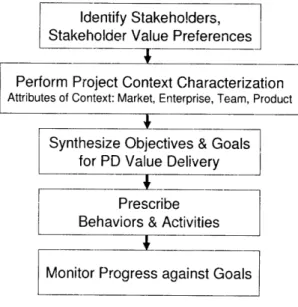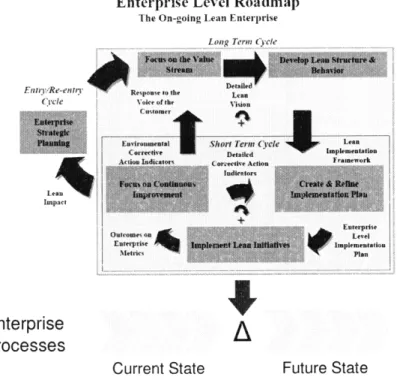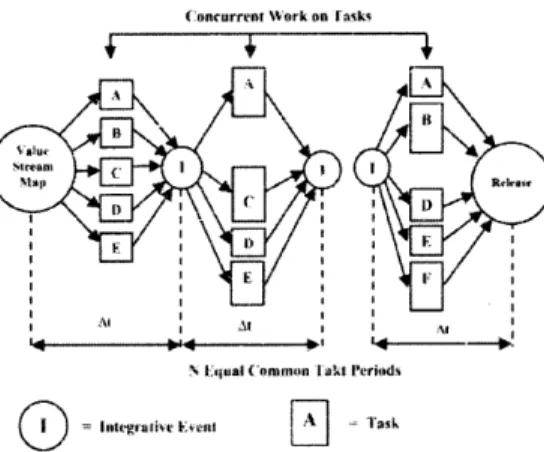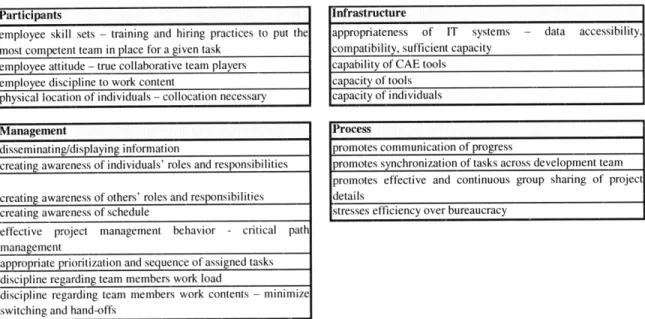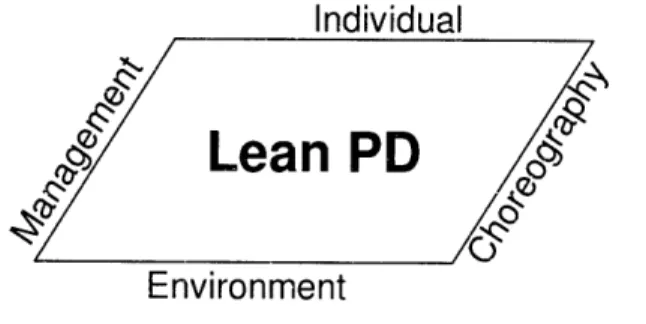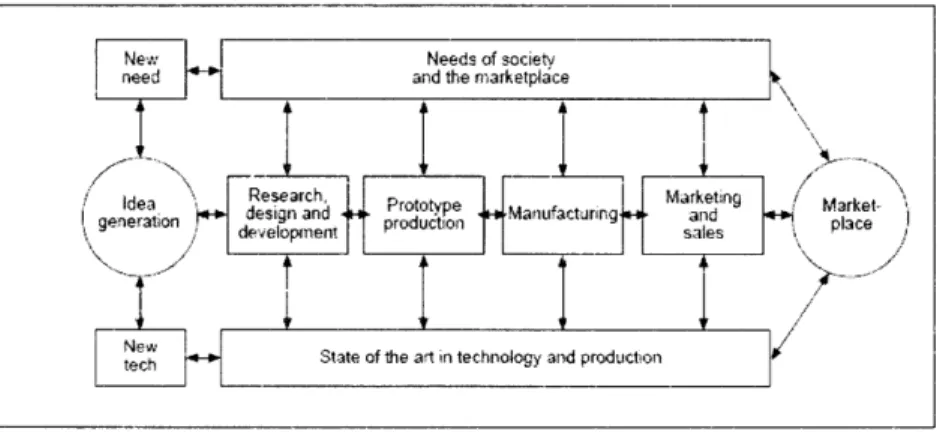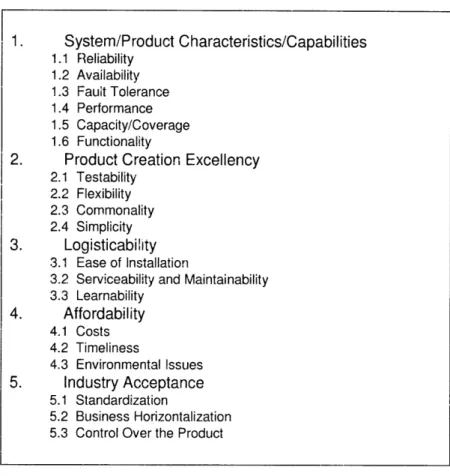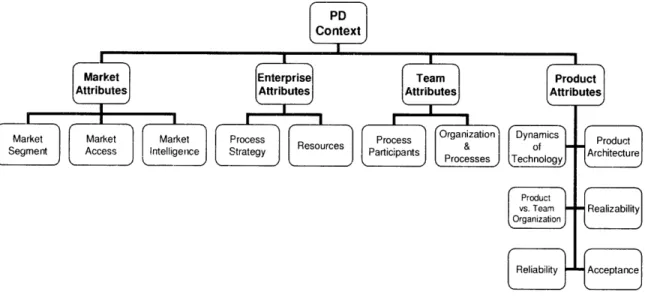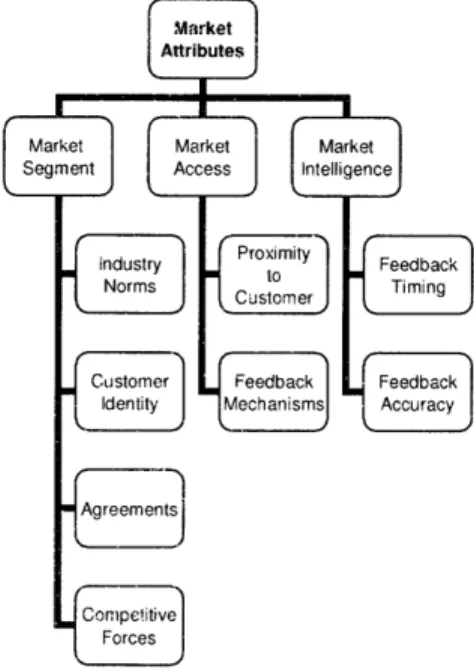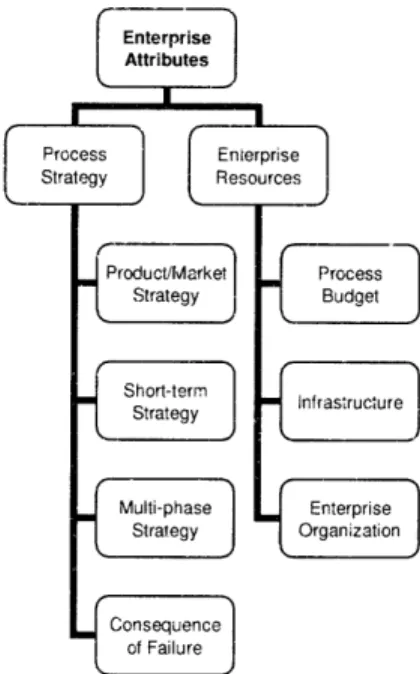Context Characterization for Synthesis of Proce
Architectures
ByChristian LaFon
ss ARCHIVES MASSACHUSETTS INSTITUTE OF TECHNOLOGYJUN
03
2009
LIBRARIES
Master of Science - Electrical Engineering, Telecommunications (2001) The Johns Hopkins University
Bachelor of Science - Electrical Engineering (1996) Rutgers University
SUBMITTED TO THE SYSTEM DESIGN AND MANAGEMENT PROGRAM IN PARTIAL FULFILLMENT OF THE REQUIREMENTS FOR THE DEGREE OF
MASTER OF SCIENCE IN ENGINEERING AND MANAGEMENT
AT THE
MASSACHUSETTS INSTITUTE OF TECHNOLOGY June 2008
© 2008 Christian LaFon All rights reserved
The author hereby grants to MIT permission to reproduce and to distribute publicly paper and electronic copies of this thesis document in whole or in part.
Signature of Author ... ...
Certified by ... ... ...
Certified by ...
r /4 / a
Christian LaFon System Design and Management Program June 6, 2008
/r- 17 .
Dr. Ricardo Valerdi Thesis Supervisor Lean Advance n tive
4ee
S ion
Patrick Hale Director System Design & Management Program
Context Characterization for Synthesis of Process
Architectures
By
Christian LaFon
SUBMITTED TO THE SYSTEM DESIGN AND MANAGEMENT PROGRAM IN PARTIAL FULFILLMENT OF THE REQUIREMENTS FOR THE DEGREE OF
MASTER OF SCIENCE IN ENGINEERING AND MANAGEMENT
June 2008
ABSTRACT
Analysis steps are proposed as an aid for establishing Lean Product Development (LPD) activities in an organization. The proposal is offered as an aid to engineering managers and process designers for coping with the unique challenges of implementing processes from their inception - for example, at a new enterprise. As such, the thesis focuses on the
creation of LPD, as opposed to traditional Lean improvement activities which benefit
from the perspective of hindsight of a legacy process. Without established product development processes to improve upon, the implementation of product development activities at a new venture relies on the use of foresight to instance a LPD environment in new organizations. Therefore, the paper stresses stakeholder value delivery within the specific context that an enterprise operates and competes. A generic framework for context characterization is proposed and discussed. The framework is then evaluated for its usefulness in process design activities. The analysis steps are based on literature review and case study interviews.
The proposed analysis steps include:
* a comprehensive definition of the business context in which the enterprise operates and competes,
* a statement of goals and objectives for the product development organization based on this context, and,
* a determination of appropriate behaviors to meet these goals.
Traditional Lean research has typically been approached from a large-scale, complex systems, for-profit perspective. Unique insights are gained from the perspective of small, privately funded, new ventures. The benefits include foresight-only value objectives for product development (process creation) and uniqueness of context (i.e. resource limited, mindshare-driven). The analysis method was validated by examining process design case studies within three contexts: large-scale aerospace, industrial process monitoring, and high-technology start-up.
Acknowledgements
My thesis journey could not have been completed without a support network of friends and family for which I am sincerely grateful.
To my wife, Patti, for her tireless support and understanding. Words cannot express my optimism for our future and for our young family.
To my parents, who provided love and opportunity such that few obstacles have stood in the way of dreams. To my sister, Michele, for the loyalty and consideration she has expressed to me my entire life.
To Dave, for inspiration and friendship (and for providing shelter during my stay at MIT). To Spiros, for polite and successful collaboration.
Special thanks to my thesis advisor, Ricardo Valerdi, for his guidance, patience, and perseverance over a long process.
Table of Contents
1. In troductio n ... 8
1.1. Motivation... ... 8
1.2. Problem Statem ent ... . 10
1.3. Product Development Process Architecture and Corporate Strategy ... 10
1.4. Product Development Process Architect ... 11
1.4.1. Proposed Steps for Architecting Processes ... 12
1.4.2. Stakeholder Perspectives ... 12
1.4.3. C ontext... 13
1.4.4. Product Development Goals and Objectives ... . 13
1.4.5. Value of Product Development... 13
1.5. Lean Improvement Initiatives ... 14
1.6. Lean Process Creation... 15
2. B ackground ... ... ... 17
2.1. Lean Enterprise Concept... 17
2.1.1. Lean Enterprise Foundations ... ... 17
2.1.2. Lean Enterprise Composition ... 18
2.1.3. Lean Enterprise Summary ... 20
2.2. Product Development ... . 20
2.2.1. Product Development... 20
2.2.2. D efinition ... 20
2.2.3. B oundaries ... ... 2 1 2.2.4. Roles and Responsibilities ... 21
2.2.5. Resources, Targets and Goals... 22
2.2.6. Product Development Summary ... 23
2.3. Lean Manufacturing 4 Lean Product Development Translation... 23
2.3.1. Manufacturing versus Product Development... ... 24
2.3.2. Identifying Product Development Value ... 27
2.3.3. Product Development Value Stream ... 33
2.3.4. Product Development Flow ... 37
2.3.5. Product Development Pull ... 38
2.4. Lean Product Development Summary ... 38
2.4.1. Common Research Approaches ... ... 39
2.4.2. Components of Lean Product Development ... . 41
3. Product Development Context... 43
3.1. Four Perspectives for Context Characterization ... 45
3.1.1. Product-Market ... 46
3.1.2. Industrial Organization (IO) Economics Models ... 46
3.1.3. Organizational Theory ... 48
3.1.4. Systems Architecture .... ... 49
3.1.5. Section Conclusion ... 51
3.2. Components of Product Development Context ... 52
3.2.1. Market Attributes ... 53
3.2.2. Enterprise Attributes ... 57
3.2.4. Product Attributes ... 62
3.3. Variations and Similarities of Context. ... 68
3.3.1. A nalysis O verview ... 68
3.3.2. Case Study Interviews... 69
3.4. Section Conclusions... 71
3.4.1. Reflections on Product Development Process Context ... 71
3.4.2. Updates to the Context Model after Validation ... 72
4. Goals and Objectives for Stakeholder Value Delivery ... . 76
4.1. B ackground ... 76
4.1.1. Product Development Objectives ... 76
4.1.2. Stakeholder Value Delivery ... ... ... 77
4.2. Using Project Context to Determine Goals... 78
4.2.1. Goals and Objectives from Market Attributes ... 78
4.2.2. Goals and Objectives from Enterprise Attributes ... 79
4.2.3. Goals and Objectives from Team Attributes ... . 79
4.2.4. Goals and Objectives from Product Attributes ... 80
4.3. Formulating Product Development Goals & Objectives ... 80
4.3.1. Lifecycle Value Delivery ... 81
4.3.2. Upstream Value Delivery ... 84
4.3.3. Midstream Value Delivery... 86
4.3.4. Downstream Value Delivery... 87
4.4. Goals and Objectives Case Study ... 89
4.4.1. Analysis Overview ... ... 89
4.4.2. Case Study Results... . 92
4.5. Section Conclusions... 95
4.5.1. Reflections on Goals and Objectives ... 95
4.5.2. Looking Ahead... 95
5. Behaviors and Activities for Stakeholder Value Delivery... 97
5.1. B ackground ... . . 97
5.1.1. Variations in Development Processes... ... 97
5.1.2. Using Lean to Determine Product Development Activities ... 98
5.2. Fundamentals of Lean Product Development Behavior ... 98
5.2.1. Lean Product Development Behaviors ... 99
5.3. Linking Lean Fundamentals to Process Objectives ... 107
5.3.1. D iscussion ... 107
5 .3.2 . R esults ... 10 8 6. Summary ... 111
6.1. Product Development Process Architect ... 111
6.1.1. Proposed Steps for Architecting Processes... ... 111
6.2. Product Development Context ... 112
6.2.1. Project Context... 113
6.3. Using Project Context to Determine Goals... 113
6.4. Behaviors and Activities for Stakeholder Value Delivery... 113
R eferen ces ... 115
A ppendix .... ... 119
A. 1. Market Attributes ... 120
A.2. Enterprise Attributes ... 121
A.3. Team Attributes ... 122
A .4. Product A ttributes ... 123
B. Case Study Interviews & Results... 124
B. 1. Case Study A: Plexis Gigabit Ethernet Transport Development ... 124
B. 1.1. Plexis Development Stakeholders ... 124
B. 1.2. Plexis Development Project Context ... 125
B.2. Case Study B: ProjectX Development... 134
B.2.1. ProjectX Development Stakeholders ... 134
B.2.2. ProjectX Development Project Context... 134
C. Objective/Behavior Comparison Tables ... 143
C. 1. Lifecycle Comparison ... 143
C.2. Upstream Comparison ... 144
Table of Figures
Figure 1.1 Figure 1.2 et al., Figure 1.3 Figure 2.1 Figure 2.2 Figure 2.3 Figure 2.4 Figure 2.5 Figure 2.6 Figure 3.1 Figure 3.2 Figure 3.3 Figure 3.4 Figure 3.5 Figure 3.6 Figure 3.7 Figure 4.1 Figure 6.1 Figure 6.2 Figure 6.3 Figure A. 1 Figure A.2 Figure A.3 Figure A.4 Figure A.5Table of Tables
Adapted from Bauch's "Checklist for Waste Elimination" ... 40
Ulrich & Eppinger's Goals of a Structured PDP ... . 76
Crawley's "Key Differences in PDPs" . ... ... 97
Rebentisch's Getting Practical: Some Lean PD Things to Do... 99
Objective/Behavior Comparison (excerpt) ... 107
Lifecycle Objectives/Lean PD Behavior Comparison ... 143
Upstream Objectives/Lean PD Behavior Comparison... 144
Mid- and Downstream Objectives/Lean PD Behavior Comparison ... 145
Architecting Processes for Value Delivery ... . 12
TTL Roadmap in Relation to Enterprise Processes (adapted from Bozdogan 2000) ... . . ... 14
TTL Roadmap for Process Creation (adapted from Bozdogan et al., 2000). 16 Slack's Employee Value ... 32
Bowen and Lawler's Employee Empowerment Approach to Service ... 32
Chase's Value Delivery Framework... ... 33
Oppenheim's "Lean Product Development Flow" ... 38
Chase's "Framework for Delivering Value in Product Development" ... 40
Components of Lean Product Development... ... 41
Rothwell's "Third Generation Process"... ... 45
Architecture Evaluation Framework ... ... 51
Model for Context Characterization ... 52
Market Attributes of Context... 53
Enterprise Attributes of Context... ... 57
Team A ttributes of Context ... ... ... 60
Product Attributes of Context... ... 62
Process Objectives Template... 91
Analysis Procedure for Value Delivery... 112
M odel for Context Characterization ... ... 112
Process Objectives Tem plate... 113
Context Model for a Development Project... 119
Market Attributes of Product Development Context... 120
Enterprise Attributes of Product Development Context... 121
Team Attributes of Product Development Context... 122
Product Attributes of Product Development Context... 123
Table Table Table Table Table Table Table Table 2.1 4.1 5.1 5.2 5.3 C.1 C.2 C.3
1. Introduction
This thesis investigates the role of the process architect and the challenges of process design in a product development organization. The strategic role of product development is emphasized, with a focus on stakeholder value delivery within the context of the development effort: business environment, enterprise capabilities and resources, team composition, and product architecture. The context of the development effort within its marketplace informs goal setting for the product development organization, management, and the team. The paper explores the utility of Lean Product Development as an aid for process creation, decision making, and continuous improvement.
1.1.
Motivation
Superior processes lead to competitive advantages.
Business leaders have an interest in process design because they recognize that the ways in which organizations go about delivering products and services are potentially as important as the characteristics of the products and services delivered. That certain companies can consistently reach their market either with higher quality, in less time, or while incurring fewer costs than competitors is the prime motivation for this work.
The notion that competitive advantages are achieved through process innovation has been demonstrated in Lean manufacturing organizations and others, in a variety of industries. Toyota and Dell, for example, have created process advantages over their competitors through maximization of production efficiencies. Toyota's revolutionary production processes have led to remarkably high quality standards in relation to their competitors (Liker, 2004). In the case of Dell, production and supply chain strategies have helped to maximize operating margin in an industry where profits are notoriously difficult to achieve (Kraemer & Dedrick, 2002). Both cases are excellent examples of companies that have used process innovation to differentiate themselves in partially, or even fully commoditized markets where product differentiation is otherwise difficult to achieve. These examples highlight the potential hidden value of enterprise processes. In the view of Barney (1996), "a firm's resources and capabilities are valuable if; they reduce a firm's costs or increase its revenues, or if, they enable the firm to respond to environmental threats or opportunities." Further, resources result in sustained competitive advantages if they are valuable, rare, and inimitable, and if the organization (Barney, 1996, p. 162) of the firm is such that these resources can be exploited. In both the cases of Toyota and Dell, innovative production processes have emerged as differentiating, competitive resources. Other factors being equal, companies like Toyota and Dell retain competitive advantages over time because of operational efficiencies executed along the supply chain and on the production floor.
It is motivating to imagine how certain advantages can be obtained through choices made when designing product development processes as well. The way in which a product development team is organized, their experience and motivation, and the infrastructure
and tools at their disposal - are all critical factors which can affect a product's quality,
cost, and time-to-market. The behaviors and activities of engineering leaders and development teams, within the environment provided by the enterprise, may result in competitive advantages, or in rare cases, disadvantages.
How appropriate are the processes employed to the task at hand?
Critical characteristics of product architecture contribute to define the appropriateness of culture and behavior of an organization. For example, Toyota's reputation and standard for reliability in its automobiles sets an enormous precedent for their manufacturing approach - the level of precision required of tools and machinery, and the extent of coverage of test cases. Critical product traits such as reliability are of primary consideration for determination of appropriate development behaviors and activities. In addition to product traits, other critical factors must be considered when deciding what methodologies are appropriate for a product development organization - the company's resources, market position, and customer relationships are examples.
These factors and others contribute to define the context in which the company operates, and must be comprehensively analyzed before decisions are made about the appropriate mode of operation for the product development team. The focus of this work is to uncover the predominant contextual factors to consider when determining appropriate behaviors for achieving strategic goals.
Process design is a difficult, but necessary task for technology companies.
Whether to improve processes and behaviors or to innovate them, the challenge of process design is a real and necessary task for technology companies. Process design decisions are necessary as a process must frequently be incrementally improved: adapted to changes in market conditions, changes in the products manufactured, or changes in customer demands. Occasionally, as in the case of Toyota and Dell, processes are
innovated, or overhauled to radically new models. In certain circumstances processes are
even architected "from scratch" - perhaps best exemplified at a new enterprise where the behaviors entire organizations are almost entirely undefined. In all cases, capabilities are required for the design of process architecture - technology companies must make determinations as to the environment provided, the organization of technical individuals, and how problem solving is implemented. Process design, and in particular the unique challenges of process creation, forms the main motivation for this thesis.
In the universe of process styles and approaches, how does one select the most appropriate behaviors when given the opportunity to improve, innovate, or define processes "from scratch "?
Starting off on the right foot.
Processes, behaviors, and their participants - perhaps in place for decades - establish a culture that defines an engineering organization. As processes and behaviors define culture, process change equates to culture change. Implementing culture change can be a notoriously difficult proposition in many companies, as evidenced in Lean transformation literature (Bozdogan et al., 2000).
For new ventures, starting off on the right foot with regards to culture is critically important, and serves as a final motivation for this thesis. It is clearly best to establish the right approaches from the onset, as culture will be increasingly difficult to manipulate as time passes.
1.2. Problem Statement
Organizations must continually adapt their processes and behaviors to keep pace with the dynamics of changing market conditions. When the performance of a particular process is insufficient for the goals at hand, the process must be evaluated and transformed. Therefore, engineering leaders are in need of tools and methods to aid in process evaluation and design.
Provided that existing processes are relatively well matched to the dynamics of a particular market, these adaptations may require only incremental changes to existing processes, or process improvements. Occasionally, existing processes must be radically changed to match the unique demands of a particular market, or a product development organization may need new processes altogether. In these instances, process design decisions may require process innovations, or process creation.
In either case, technology companies must provide the appropriate environment, build a development team, and prescribe the right behaviors. In regards to environment, what infrastructure should be provided? In regards to individuals, what are their motivations, and experiences? In regards to the choreography of the development team, how are effective communication channels ensured?
Traditional Lean process initiatives are known to be useful for the former case described above - the case of incremental change, or process improvement. It can also be demonstrated that Lean is useful for the latter case, that of process creation. In support of this hypothesis, this thesis formulates an analysis methodology for determining product development goals and objectives within a specific context, and for applying Lean principles for process creation in fulfillment of those objectives in product development organizations.
1.3.
Product Development Process Architecture and Corporate
Strategy
The Lean philosophy promotes a strategic view of enterprise processes. From LAI's Transition-to-Lean Roadmap, Volume 2:
"The idea to consider the Lean paradigm need not originate in the executive offices of the Enterprise. It can originate at any level in the organization. Ultimately, though, its consideration must be pursued as a major strategic issue for the Enterprise. In fact, to be successful, any effort to transform an Enterprise must be totally compatible with, and ideally an
outgrowth of, the Enterprise's strategic planning process." (Bozdogan et al., 2000)
The strategic role of the product development organization in an enterprise is to provide the right technology, at an appropriate price (Womack & Jones, 1996), and with the right timing to enable the enterprise to operate and compete effectively in a particular marketplace. In this manner, the product development organization is considered a tool that is employed by the enterprise to fulfill its strategic needs with regards to products and technology. Process should be designed around strategy - strategy drives process, and process drives organization (Kiraka & Manning, 2005). Furthermore, as the strategic needs of the organization change, so does the strategic role of the product development organization. In order to serve the strategic needs of the enterprise, the process should deliver value to all of the stakeholders of the product development process.
1.4. Product Development Process Architect
In many of today's technology companies, product development processes are typically implemented corporate-wide with a single formula for all current active projects in the enterprise. Product development processes are created by members of engineering leadership (i.e. engineering management, project engineering, project management) or by consultants brought on only temporarily to evaluate, critique, and restructure processes. Process redesign, if and when it occurs, is typically a landmark event with enormous cultural implications for the organization.
To emphasize and support the strategic importance of product development to technology companies, this thesis explores the notion of a Product Development Process Architect as a permanent, full-time organizational role in the high-technology enterprise. The role of the process architect is to advise, design and advocate for product development environments that evolve to deliver value to all process stakeholders, consequently satisfying the dynamic, strategic needs of the enterprise.
The product development process architect must be a holistic, systems thinker with broad and deep understanding of a variety of influential factors. First, the process architect must have market knowledge and business training. The process architect must have a comprehensive knowledge of the enterprise: its organization, supporting processes, and
resources. The process architect must have comprehensive knowledge of the
development staff: their personalities, work preferences, and their experience. Finally, the process architect has knowledge and experience with products, training in systems and architectures, and must maintain a working relationship with the product architects themselves. The process architect must communicate with the enterprise, its leadership, and development staff. The architect must have credibility with, and the respect of the development team, and must have the ability to persuade and influence behaviors, and indeed effect cultural change where necessary.
The role of the process architect should be a relatively independent role - the architect should not be a participant in the process, nor a strict representative of the customer or
the enterprise - such that the role should not be biased too heavily by an individual
stakeholder or by the current organization of the enterprise, business unit, or functional department. Still, the process architect must be a permanent member of the enterprise, (in lieu of a consultant, for example) due to the required level of intimacy with the organization and the staff.
1.4.1. Proposed Steps for Architecting Processes
As stated above, the role of the process architect is to design, advise, and advocate for the components and characteristics of a product development environment which deliver the strategic needs of the enterprise. The following procedure is proposed as an analysis methodology for determination of appropriate process architectures.
Identify Stakeholders,
Stakeholder Value Preferences Perform Project Context Characterization Attributes of Context: Market, Enterprise, Team, Product
Synthesize Objectives & Goals for PD Value Delivery
Prescribe Behaviors & Activities
Monitor Progress against Goals
Figure 1.1 Architecting Processes for Value Delivery
This analysis procedure is explored throughout this thesis. Throughout the exploration, the role of the product development process architect is expanded upon in detail.
1.4.2. Stakeholder Perspectives
As stakeholders of the enterprise, the topic of product development process design and methodology is of interest to engineering managers, technical leaders, and participating engineers alike. Management strives to align processes with corporate goals. Technical leaders desire to organize teams tactically for delivering technology to the enterprise in fulfillment of business objectives. Process participants require the infrastructure and coordination necessary to meet quality, cost, and schedule constraints - all while maintaining a healthy work-life balance.
When considering the various stakeholders of the product development process, several interesting questions come to light. What do stakeholders from different industries value
in common, what do they value differently? What characteristics of the product development process can be manipulated to maximize value for a particular stakeholder? What are the linkages between these value perspectives and modes, or styles, of behavior?
To answer these and similar questions, the process architect must begin by holistically considering the environment surrounding the development effort and its various stakeholders. Architecting a product development process with the objectives of enterprise stakeholders in mind requires a characterization of the context in which the enterprise, its processes, and its stakeholders exist.
1.4.3. Context
"Process design is a management decision and must be made by considering several factors: size and complexity of project, whether or not we've done this before (precedentedness), ability of the team, schedule, etc." (Boehm and Turner, 2004)
The words of Boehm allude to some of the many components of context: product traits, traits of individual team members, competition, resources, access to customers, and experience. The implication of factoring the uniqueness of team and product attributes into the project context is that the process architect will likely prescribe unique behaviors and activities for each of the current active projects in the enterprise. In Chapter 3, a detailed analysis of these and other components of context are presented.
1.4.4. Product Development Goals and Objectives
Once captured and understood, how does the contextual environment translate into goals for the team? Broadly, the product development organization aims to deliver and ultimately maximize value to its stakeholders. Unfortunately, process goals as derived from stakeholder value delivery remain ambiguous without considering the contributions of the greater context of the development project. Process goals derived from the project context are explored in Chapter 4. The prime outcomes of this thesis are clear and concise goals for the development team and the process itself.
1.4.5. Value of Product Development
Product development processes are the behaviors, activities, and methodologies employed to achieve the goals and objectives of the product development organization. The value of product development (Chase, 2001) lies in its ability to meet or exceed these goals. While there are many types of behaviors employed by development teams today, the most appropriate behaviors for a particular team (within a particular context) are of particular interest. It is critical to architect and choreograph product development activities to most efficiently achieve strategic corporate goals. In Chapter 5, the use of Lean Product Development in translation of goals to behavior is explored.
In summary, the architecture of product development activities should only be created after a stakeholder value analysis is completed within an appropriate context. The contextual environment informs a suitable strategy for fulfillment of corporate goals, while the activities of the product development organization are the strategy put into action. Finally, the value of product development activities lies in the extent to which they deliver on the various strategic goals.
The following sections briefly review Lean process improvement initiatives and introduce the notion of Lean process creation, both of which complement the type of analysis described above.
1.5. Lean Improvement Initiatives
The Transition-to-Lean (TTL) Roadmap (Bozdogan et al., 2000) proposes an iterative transformation cycle where enterprise processes are transitioned towards Lean. Using the TTL Roadmap, an enterprise is encouraged to first determine strategic goals, and second to implement them via processes. The following figure presents the TTL Roadmap, which has been amended to highlight its relationship to enterprise processes and their transformation from "current state" to a Leaner, "future state".
Enterprise Level Roadmap The On-going Lean Enterprise
Long Term Ccle
FnhtrRe -eanrt, Response to the Lean
c|,cle oice of the Vision
CtiuCtomesr ...
~Env i Short Term Ce Lean C orreic e Detailed bImplementation
ctoon Idicator Cor,ecete Action Framework
impact
eImnpl me
Enterprise
Processes
Current State Future State
Figure 1.2 TTL Roadmap in Relation to Enterprise Processes (adapted from Bozdogan et al., 2000)
The iterations in the TTL Roadmap emphasize the spirit and philosophy of continuous improvement, a foundation of Lean initiatives. As revealed in the detail of the figure, each cycle of the transformation involves; an evaluation of the current strategic performance of the enterprise, a reevaluation of strategic goals, planning and preparation
for process improvements, and finally implementation of process change.
The transformation cycle can be thought of as a combination of hindsight and foresight utilized by the enterprise to continuously improve processes. Hindsight is used to monitor the alignment of outcomes with goals, and foresight to make adjustments to behaviors to improve this alignment. Relatively abrupt adjustments are made in earlier stages, while perhaps only incremental adjustments are made in later stages when the Lean transformation matures and alignment improves.
1.6.
Lean Process Creation
Continuous improvement initiatives, such as Transition-to-Lean, scrutinize enterprise processes and behaviors to identify and eliminate inefficiencies and wastes. As such, an improvement initiative implies the existence of the current state. As mentioned above, monitoring and observing the current state of processes requires and exploits the benefits of hindsight.
How can the TTL Roadmap be useful to process architects designing new processes? Process architects in new organizations, for example, do not have existing processes to incrementally improve. In a sense, creating, planning, and implementing strategic behaviors requires a reliance on foresight only.
The following figure presents the TTL Roadmap again, this time amended to highlight the unique challenges of process creation. In the figure, the benefits of hindsight are removed (grayed out). The process architect must rely solely on foresight - a comprehensive stakeholder value analysis, within a specific context - to aid in process design decisions. Additionally, emphasis is placed on creation of the initial state.
use of foresight
-deliver stakeholder value
within a context
I9 f,.,..i 4
Enterprise Level Roadmap The On-going Lean Enterprise
STern (le
process creation
TTL Roadmap for Process Creation 2000)
(adapted from Bozdogan et al.,
After the benefits of hindsight are removed, process architects are left with strategic planning and goal setting for definition and implementation of an environment for Lean activities to flourish. Without a current state to improve upon, process designers must define processes and behaviors from scratch - that is, definition of the beginning, or initial state. Once the initial state is defined, the enterprise can enter the normal continuous improvement cycles of the TTL Roadmap as a transforming entity. The challenge for process architects is to define the initial state as appropriately as possible for the task at hand.
2. Background
2.1.
Lean Enterprise Concept
Lean is a set of principles, practices and tools aimed at business process improvement. Inspired by revolutionary manufacturing initiatives first used by Henry Ford and adapted and perfected further by Toyota, Lean has evolved from a characterization of Toyota's revolutionary manufacturing practices into a sophisticated field of study impacting business processes across the enterprise. Lean Product Development is the subset of Lean research that applies the Lean philosophy into the product development function of the enterprise. To develop an understanding of Lean Product Development, it is critical to understand this evolution.
In the following sections a review of the evolution of Lean is presented; first, a brief history of Toyota and the genesis of Lean, next, the adaptation and translation of Lean principles to other business processes, and finally, the fommulation of the notional Lean Enterprise. In this manner, Lean Product Development is captured as a process operating within the Lean Enterprise.
2.1.1. Lean Enterprise Foundations
Toyota's long history of production excellence has been a topic of investigation by the academic and industrial communities for many years. Volumes of literature are available discussing the practices and principles of Toyota, formulating theories of Toyota's success, and testing those theories at other firms. Additionally, many theses have traced the history of Toyota and summarized the collection of Lean manufacturing literature. Slack (1999), Chase (2001), Whitaker (2005) are comprehensive, and are recommended for review. There is no lack of recounting of neither the history of Lean, nor the production practices and successes of Toyota, and therefore no need to comprehensively retrace those steps here.
Briefly then, after WWII, events in Japan forced Toyota into a new manufacturing paradigm. With limited finances and resources, automobile manufacturing simply could not proceed following the mass production model. New techniques were developed to accommodate a build-to-order system more appropriate in post war Japan. These techniques developed and evolved and were successful, particularly at Toyota.
Over time it became apparent to the global automobile industry that the Japanese approach was working. Consequently, armies of industry experts and academics traveled to Japan to study Toyota's methods. Toyota's processes were found to be radically different than others'. These investigations have resulted in literally volumes of studies, books, and theses. Over time, the collection of this literature, along with its resultant principles and methods, has come to be accepted as Lean. Today, Lean is widely covered in academic literature, widely trusted and accepted in industry, and is widely practiced. Lean has been applied worldwide in manufacturing, and indeed has revolutionized the industry.
As the manufacturing environment became adequately characterized, further studies revealed that Toyota's processes extended beyond their own manufacturing floor, to influence their suppliers. Toyota had learned to approach their supplier network in new and interesting ways as well, extending their revolutionary ideas horizontally along the process chain feeding the automobile manufacturing process. This extension was proposed along the entire supply-chain, from raw materials to finished goods. These new insights, along with the successes of Lean improvements in production, inspired many to suggest the applicability of Lean principles as directed towards other business processes as well - specifically, business processes outside of the production process chain altogether. Lean Thinking (Womack & Jones, 1996), for example, has inspired many to consider Lean as appropriate for order fulfillment and product development, in a variety of industries.
In many cases, this meant reaching across traditional corporate barriers, both internal and external to the company. To apply the lessons of Lean, a new cooperative relationship among firms was necessary. Lean Thinking first proposed this inter-corporate
cooperation as a concept known as the Lean Enterprise. As time has passed, additional studies and principles have emerged to characterize Lean behavior in firms. These proposals have been accepted into the Lean literature, and have contributed to the Lean Enterprise concept as well.
Lean studies have matured to redefine the traditional view of the "enterprise". Once clearly delineated by a corporation's physical boundaries, the new notion of the enterprise - the Lean Enterprise - is now defined solely by those processes and individuals participating along a product's lifecycle. These processes and individuals use Lean practices to deliver value to the various stakeholders of the enterprise. Today, the notional Lean Enterprise truly embodies a holistic, value-oriented, extended enterprise, applying Lean techniques both vertically and horizontally across multiple business processes and corporate boundaries.
2.1.2. Lean Enterprise Composition
Defining the Lean Enterprise requires a translation of the successes of Lean to processes external to the manufacturing environment. An appropriate method of translation is first to identify the guiding principles at work in Lean production processes. Once abstracted, these principles are then reconditioned to be applied within other process domains. The translation suggested here has been tackled by a number of researchers with notable results, some of which are referenced below.
In addition to the "principle-practice" translation described above, the Lean Enterprise is further defined by a number of notable concepts adopted and developed by Lean research. Some of which have been inspired by Toyota's other behaviors - outside of manufacturing. For example, investigations into Toyota's own product development organization have been made (Morgan, 2006), leading to additional insights. These and
other insights have been adopted by Lean studies to enrich the definition of the Lean Enterprise.
2.1.2.1. Toyota Production -) Lean Principles
The most well known statement of the principles at work in the Toyota production system are the five guiding principles identified by Womack and Jones in Lean Thinking (1996):
1) Identify Value,
2) map the Value Stream and identify Waste,
3) eliminate Waste and promote Flow,
4) implement Pull along the Value Stream, and, 5) pursue Perfection.
While working to define Lean Product Development and the Lean Enterprise, many have anchored arguments and thinking within the Five Principles (Slack, 1999; Chase, 2001). Also commonly cited are Ohno's Wastes (Walton, 1999; Wake, 2003). Ohno's Wastes, the Five Principles, and other themes are presented in detail in succeeding sections. In the translation of Lean initiatives to the enterprise, themes such as Ohno's Wastes, the Five Principles identified by Womack and Jones, and other Lean concepts are used as
principles. They are abstract concepts resulting from years of observation and study, by
many researchers, of Toyota's revolutionary production techniques. Originating as
practices on the manufacturing floor, these principles have been abstracted from practices
in order to characterize an approach so successful, and so vastly different than any other of its time. The step required for translation must now be to analyze and interpret them for use in non-manufacturing environments.
2.1.2.2. Lean Principles -- Lean Processes
As mentioned above, since Lean Thinking was written many have speculated that Lean tools and principles can be applied to business processes outside of manufacturing. Again, the rewards of the Lean philosophy are real, and their contribution to the success of companies like Toyota are widely accepted and acknowledged. Therefore, the temptation to apply the Lean philosophy corporate wide is understood. While it is easy to suggest that the principles should be used, an adaptation is necessary to effectively apply Lean principles for use outside of manufacturing. The appropriate adaptation is the subject of many works.
Manufacturing has unique characteristics and traits that are fundamentally different than other business processes. These differences prevent direct application of Lean practices, forcing one along the path of translation described here. Much of the work referenced in this thesis have grappled with this translation, conducting a rigorous investigation into how these principles should be transformed back into practices, appropriately, within the context of the target process.
2.1.2.3. Enterprise Toyota
The concept of the Lean Enterprise is complicated somewhat by additional research, in which Toyota's other enterprise behaviors are being characterized. Notably, Morgan (2006) examined Toyota's actual product development practices.
2.1.3. Lean Enterprise Summary
Together, these studies are forming the picture of the Lean Enterprise as it stands today. In general, the Lean Enterprise is being defined by a variety of applications of the Lean philosophy in various aspects of the enterprise. These applications include Lean manufacturing, a translation of Lean principles to other business processes, and an occasional look at Toyota's behavior outside of manufacturing.
A Lean Product Development organization operates within the Lean Enterprise. Much of the work done to define Lean Product Development has centered on adapting Lean principles for use in a product development context. In the sections that follow, research aimed specifically at defining Lean Product Development is reviewed.
2.2.
Product Development
2.2.1. Product Development
An investigation into Lean Product Development requires a discussion of the notional organizational function of product development, that is: its definition, its boundaries, and finally the role that product development plays in, and its responsibility to, the greater organization.
2.2.2. Definition
An organization, for various strategic reasons, makes determinations about which marketplaces in which to participate and compete. Whether for profit or for other strategic goals, the organization must produce products and solutions for introduction into that marketplace. Product development is the organizational process that designs and creates products and solutions, for fulfillment of the organization's strategic needs for a particular marketplace. Broadly, product development is a socio-technical system composed of the individuals, methods, and resources employed to approach problem solving. Designers and engineers, their communications and interactions, the tools and techniques at their disposal, and the complexity of the problem at hand all contribute to characterize this system.
Ulrich & Eppinger (1995) define product development as "the set of activities beginning with the perception of a market opportunity and ending in the production, sale, and delivery of a product." Naturally, these activities include processes operating external to
classical design and development engineering (for example, marketing and production). While it is true that many organizational processes are ideally involved in the product development process, Lean Product Development literature generally focuses on the activities of engineers participating in technical problem solving in a product development context. These participants include architects, designers, testers, team leaders, project managers, etc. Ultimately, it is from their perspective that Lean Product Development will be defined. Therefore, further clarification of the boundaries of product development is useful.
2.2.3. Boundaries
Broadly speaking, there are at least four main phases, or stages, in "the product lifecycle" (Crawley, 2005): the Concept phase, the Design phase, the Integration & Test phase, and the Operating phase. The Concept phase generally includes marketing activities, customer needs gathering, competitive analysis, and feasibility studies. The Design phase includes system architecture and detailed design activities. The Integration and Test phase includes the construction and evaluation of prototypes, proof of concept, and refinement of design details. The Operating phase includes production, fielding, and sustaining of the product.
To distinguish the product development activities of designers and engineers from that of marketers and assemblers, the Design and Integration & Test phases of the product lifecycle roughly bound the primary phases of interest for Lean Product Development research. While various other viewpoints exist regarding the exact boundaries of the product development effort (Ulrich & Eppinger's definition, for example) it is not necessary to resolve this contention here. The intention is to establish product development boundaries for discussion purposes, most particularly since we are attempting to define new Lean processes outside of manufacturing and production. Therefore, for discussion purposes, the boundaries of product development are taken as a subset within the overall product lifecycle defined above, beginning at the Design phase (generally downstream of concept development activities) and ending at the Integration & Test phase (generally upstream of production).
2.2.4. Roles and Responsibilities
Functioning within the boundaries established above, the role of product development in the larger enterprise is to materialize various product concepts and to produce plans for production. The materialization of a product concept requires an exploration into the greater set of possible problem solutions, a down-selection of said solutions, building, testing, and comparison of a chosen subset of solutions, and finally convergence on an appropriate alternative. Ideally, the processes employed result in plans for production that are feasible, reliable, and otherwise generally attractive to potential customers.
In this manner, product development provides the corporation with tools - in the form of physical products - to show, sell or otherwise operate and compete in a marketplace. The methods and procedures used by the product development team to produce these tools
can vary in their effectiveness, timeliness, and costliness. It is the responsibility of the product development organization to deliver results as efficiently as possible.
2.2.5. Resources, Targets and Goals
The product development team is constrained by the quantity and quality of resources at their disposal. The two main resource categories are people (headcount, expertise, experience, and motivation) and their environment (facilities, infrastructure, tools, etc.). A budget is created to staff and tool a project as determined by management. As a project runs its course, resources are typically evaluated, negotiated and adjusted as necessary.
Utilizing the resources granted above, the product development team strives to meet quality, cost, and schedule targets for a given project, all of which impact the company's success. The product development team uses metrics to monitor behavior and progress along all three categories, continuously making trade-offs to keep the scope of each category achievable and appropriate for project goals.
Achieving the appropriate balance of quality, cost, and schedule in product development can prove to be somewhat recursive. Decisions regarding this balance can also affect those supporting, participating in, and depending on the process. For example, designers attempt to meet the customer's requirements for features and reliability while their design decisions commit production costs to be incurred during manufacturing. These costs affect the company's ability to profit from the sale of the product, and therefore affect the bottom line. Additionally, procedures used by designers to organize and communicate with one another to solve problems consume time, and therefore affect the ability of the product to hit the market's window of opportunity. On the other hand, aggressive schedules take tolls on employees and introduce quality uncertainty.
The Iron Triangle
The trade-offs, as defined above, tie into the classic "iron triangle" of project management. It is widely cited that these targets are frequently in contention and that "resolution of this tension has a direct bearing on customer value" (Slack, 1999). Clearly though, a balance is finally achieved as project runs its course. The question is, how should a management team tip the scales, or, (in hindsight) if the scales had been tipped differently, would the project have been more or less successful?
Consideration of the tension of the iron triangle provides an opportunity to introduce two additional perspectives on product development - that of context and that of stakeholders. Context, used here, refers to the surrounding business environment in which the company operates and competes, and in which the product will be marketed. The term stakeholder refers to any entity that relies on the product development organization to fulfill their needs and expectations. The customer, for example, is traditionally the most well-known stakeholder of the product development process, and is typically regarded as its primary beneficiary. Other critical stakeholders include the management team, who benefit from
business opportunities created by the products developed, and investors, who benefit financially from a product's ultimate success.
The concepts of business context and stakeholder viewpoints are critical when attempting to consider why organizations competing in different marketplaces will vary in their decision making with regards to the iron triangle. The variations depend on the relative weighing of importance of quality, cost, and schedule targets - as determined by various stakeholders (desires and preferences) within the context (resources and constraints) of different settings. It is useful to consider that the appropriate balance of these targets is a strategic need for the enterprise, a need that is determined by business context and stakeholder viewpoints.
Context and Stakeholders Define Balance
"Value in product development has historically been regarded as the
appropriate balance of these metrics [quality, cost, schedule]." (Chase, 2001)
In summary, the goal of the product development process is to maintain the appropriate balance of the targets of quality, cost, and schedule, as determined by context and stakeholder viewpoints. The factors influencing perceptions of value are unique to how each stakeholder participates in the enterprise, and depend largely on the context, or business environment in which the company operates. The product development process serves the needs of various stakeholders with varying needs, such as directly impacting profit, research and development of intellectual property, developing prototypes, reaching exceptional quality and reliability targets, aggressive (or specific) time-to-market constraints, or perhaps competing in a market with particularly low margins.
2.2.6. Product Development Summary
Product development involves people: developers, designers, and engineers, with specialized skills and experience, who work independently and as part of a team. Individuals and teams participate in an environment: management and infrastructure, resources and constraints, employing processes and procedures in their approach to problem solving. Teams are organized to solve technical problems, of varying complexity, while balancing quality, cost, schedule and risk. The product development organization attempts to create value for all stakeholders within the context of business and enterprise factors.
2.3. Lean Manufacturing -- Lean Product Development Translation The premise that Lean principles and practices are applicable to processes beyond the manufacturing floor gained acceptance over the course of the evolution of Lean research. Lean Product Development is a practice based on this premise. The first step in applying Lean to processes outside of manufacturing, or target processes, requires an abstraction of the principles at work behind Lean process improvements. The Five Principles, as captured in Lean Thinking (1996) are generally accepted as the most appropriate
statement of these principles. Next, the principles are reevaluated within the context of the new, target process. Throughout this reevaluation, cases of the principles at work in manufacturing are continually referenced for examples of the principle at work and the resultant improvements made, and for a general perspective on the characteristics of the process that allow the principle to play out so favorably. In this manner, it is beneficial to become acquainted with some of the mechanics of the manufacturing process, and particularly, to compare these mechanics with those of the target process.
In succeeding sections a review of Lean Product Development literature is presented. The review will sample a variety of research with regards to the reevaluation of the Five Principles while introducing a variety of topics, including product development stakeholders, product versus process value, and product development wastes. The review begins with a mechanics comparison of manufacturing and product development, our target process.
2.3.1. Manufacturing versus Product Development
In order to begin to apply Lean principles to other business processes, it is useful to first compare and contrast the mechanics of the target process (i.e. product development) to the manufacturing domain from which Lean principles were first derived. Both processes involve technical people working to solve technical problems, and aim to serve various common stakeholders - most notably the customer. Both processes scale in complexity with that of the product, and, for complex products both are particularly vulnerable to waste. These similarities provide a basis for motivating the Lean thinker to analyze product development further to test the applicability of Lean tools and techniques. Ultimately though, it is acknowledged that the two processes are sufficiently distinct that
their differences need to be characterized, sorted, and analyzed.
Many authors (Slack, 1999; Bauch, 2004; Morgan, 2006) cited a variety of fundamental differences between the two processes, and view these differences as obstacles in applying Lean Manufacturing principles towards product development. For a comprehensive look at these differences, Bauch's discussion (2004, p. 33) is recommended as a particularly thorough review. For the purposes of this discussion, a few notable distinctions are highlighted below.
Nature of Tasks
"Manufacturing processes are generally sequential in nature, they are non-iterative and they are repetitive. Contrast this with the product development process which is highly networked involving both sequential and parallel processes, it can be highly iterative with feedback loops to earlier process steps, and in general, is not highly repetitive." (Slack,
1999)
Due to the repetitive nature of the production process, improvement efforts are simple to conceive, are generally straightforward to implement, and come with tangible results.
Manufacturing assembly steps occur in plain view with obvious participants. Product development, on the other hand, is often iterative, with grey boundaries among individuals, and with less tangible results.
Analyzing the implications of these differences brings to mind the relative simplicity of human interaction required for production processes. It is interesting to note that the predictability that a repetitive process affords not only impacts technical aspects of the process, but social aspects as well. In contrast, consider the potential magnitude of the social complexity of product development activities. Multidisciplinary problem solving is largely a social activity. Product development inherently involves more complex social interaction than manufacturing, and likely more communication needed (Morgan, 2006).
Task Timing
The repetitive nature of manufacturing tasks leads to stability with regards to task completion times. In contrast, product development tasks are often new and unique problems which naturally vary in complexity - and therefore vary in timing as well. The variations of task timing in product development versus the stability and predictability of task timing in manufacturing is a characteristic difference between the two processes. The Toyota Production System has exploited the time predictability of manufacturing tasks through a concept referred to as takt time. Takt time refers to Toyota's system of task start-time/stop-time synchronization, where a sequential production process is iteratively decomposed into tasks of relatively equal duration, and execution of tasks are
synchronized across the entire assembly line. In this manner, the time predictability of individual tasks is extended to provide time predictability along the entire assembly line. Toyota has proven the benefits of takt timing to include lowered inventory buildup between tasks, improved process transparency, and a reduction of time to discover weaknesses and faults in the process. Today, implementation of takt timing is considered fundamental to Lean manufacturing initiatives, and is largely acknowledged for its positive impact on the production floor.
Many have tried to imagine a product development process where tasks are synchronized, desiring benefits such as improved schedule and staffing predictability, and more efficient management of information inventories (following sections address how poor management of information can lead to waste). Unfortunately, many have doubted that product development tasks can be synchronized, due to their time variability and unpredictable nature (Morgan, 2006). (Recall that takt time implementation is possible in a manufacturing environment mostly due to its repetitive nature.) While acknowledging the possible benefits, others have dismissed synchronization of product development tasks as an ideal impractical for an environment as uncertain as the product development environment (Slack, 1999).
Information vs. Physical Product
An important distinction between manufacturing and product development revolves around what is actually created in the process. A major hurdle in Lean studies has been
to grapple with the fact that it is injbrmation (build-to specifications, for example) that is created in product development -as opposed to physical product. Physical production in a manufacturing environment is clearly visible, countable, and verifiable. In contrast, much work in product development is intangible (Morgan, 1996). The creation of information is inherently more difficult to track and control than physical product.
Much work has been done to resolve the implications of the "information product". Bauch (2004) for example, included a detailed study of information. Information studies have led researchers to suggest improvements in the quality and flow of information in product development. Major accomplishments by the Lean community include initiatives improving communication among team members and within and among information technology (IT) systems. Human communication initiatives include displays, "war rooms", collocation, and Integrated-Product-Teams (IPTs). IT system improvement initiatives include database and data type interoperability, and improvements in tools (i.e. computer-aided-engineering tools interoperability).
It is interesting to note that some product development activities more directly impact "physical product" than otherwise acknowledged. Software developers, for example, do indeed create deliverable product. Software, while certainly less tangible than physical product, is more akin to physical product than to a build-to specification. Therefore, when contrasting product development activities to manufacturing it should be recognized that there are types of product development that are perhaps more akin to manufacturing than not.
Position of the Process within the Value Stream
Referring back to the definition of the product lifecycle, note that manufacturing is located further downstream, or closer to the final customer, than product development. There are several important implications of this relative positioning which are highlighted below.
Manufacturing enjoys proximity to the customer, improving the likelihood of market interaction and feedback. Additionally, the mission of serving the customer's needs is more clearly defined. For example, there is little ambiguity in the definition of quality in manufacturing (i.e. meeting specs and tolerances).
Feedback in product development is more difficult to cultivate, and quality therefore is harder to define, and more likely to be off target. Product development activities are burdened with uncertainty and variability of inputs to a greater extent than manufacturing. Therefore, in product development it is necessary to continually reevaluate these inputs over time.
Unfortunately, lack of access or proximity to the customer does not relieve product development of the burden and importance of constant customer involvement. Product development teams must be sure of their interpretations of customer needs - whether through pre-approved and cooperative specifications or cultivated through focus groups.
